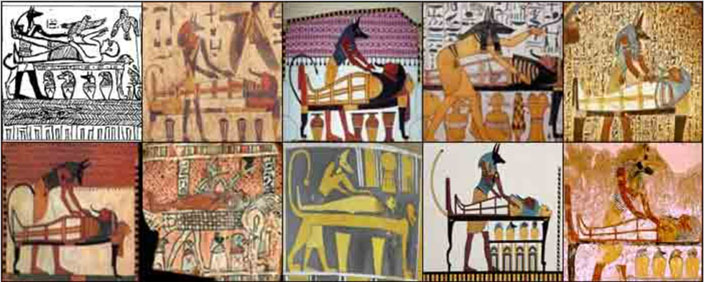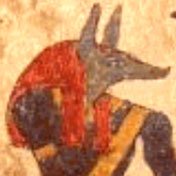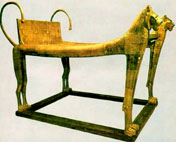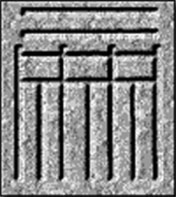Facsimile 1, top left, is a common funerary scene from the Egyptian Book of Breathing.

Common Egyptian funerary scenes. Note: the top left image is an Egyptologist depiction of Facsimile 1 restored properly.
The papyri sold to Joseph Smith are ancient Egyptian funerary documents, from the Book of the Dead and its simplified form, the Book of Breathing. In the collection were fragments belonging to at least five deceased:
- Hor
- Ta-Sherit-Min
- Nefer-ir-nebu
- Amenhotep
- Sheshonq
Comparing the Source Papyrus to Facsimile 1
Joseph Smith filled in the areas where the papyrus was damaged. Egyptologists agree that his restoration was inaccurate.| Source Papyrus Hor Book of Breathing |
Book of Abraham Facsimile 1 |
|---|---|
 |
 |
Verifying Joseph’s Translation
| Figure | Joseph Smith | Egyptology |
|---|---|---|
| 1 |
The Angel of the Lord.
|
Isis, the sister-wife of Osiris.

|
| 2 | Abraham fastened on an altar. | Osiris on an embalming table wrapped in clothes for mummification. |
| 3 |
The idolatrous priest of Elkenah attempting to offer up Abraham as a sacrifice.
|
Anubis, the Egyptian funeral god.

|
| 4 | The altar for sacrifice by the idolatrous priests, standing before the gods of Elkenah, Libnah, Mahmackrah, Korash, and Pharaoh. |
An embalming table, aka “lion’s couch” |
| 5 | The idolatrous god of Elkenah. | These are canopic jars that contain the deceased organs, and are representative of the sons of the god Hor. This one is of Qebehseneuf who receives the intestines. |
| 6 | The idolatrous god of Libnah. | These are canopic jars that contain the deceased organs, and are representative of the sons of the god Hor. This one is of Duamutef who receives the stomach. |
| 7 | The idolatrous god of Mahmackrah. | These are canopic jars that contain the deceased organs, and are representative of the sons of the god Hor. This one is of Hapy who receives the lungs. |
| 8 | The idolatrous god of Korash. | These are canopic jars that contain the deceased organs, and are representative of the sons of the god Hor. This one is of Imsety who receives the liver. |
| 9 | The idolatrous god of Pharaoh. | The Egyptian god Horus or Sobek whose head is a crocodile. |
| 10 | Abraham in Egypt. | Funeral offerings covered with lotus flowers. |
| 11 | Designed to represent the pillars of heaven, as understood by the Egyptians. |
“Serekh” representing a gated facade of a palace, thus signifying that the ceremony took place behind the wall inside the palace.

|
| 12 | Raukeeyang, signifying expanse, or the firmament over our heads; but in this case, in relation to this subject, the Egyptians meant it to signify Shaumau, to be high, or the heavens, answering to the Hebrew word, Shaumahyeem. | Water the crocodile swims in. |






